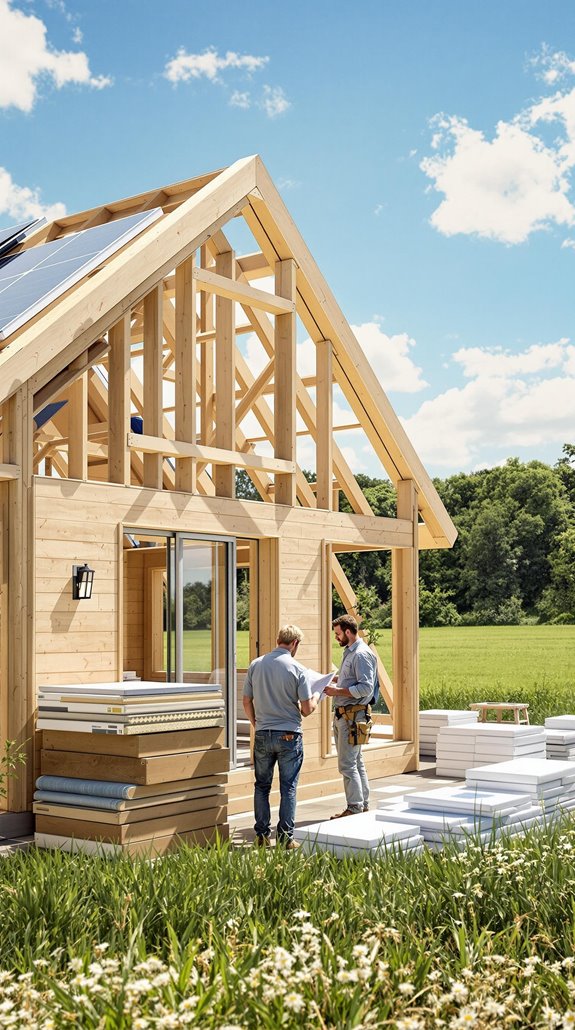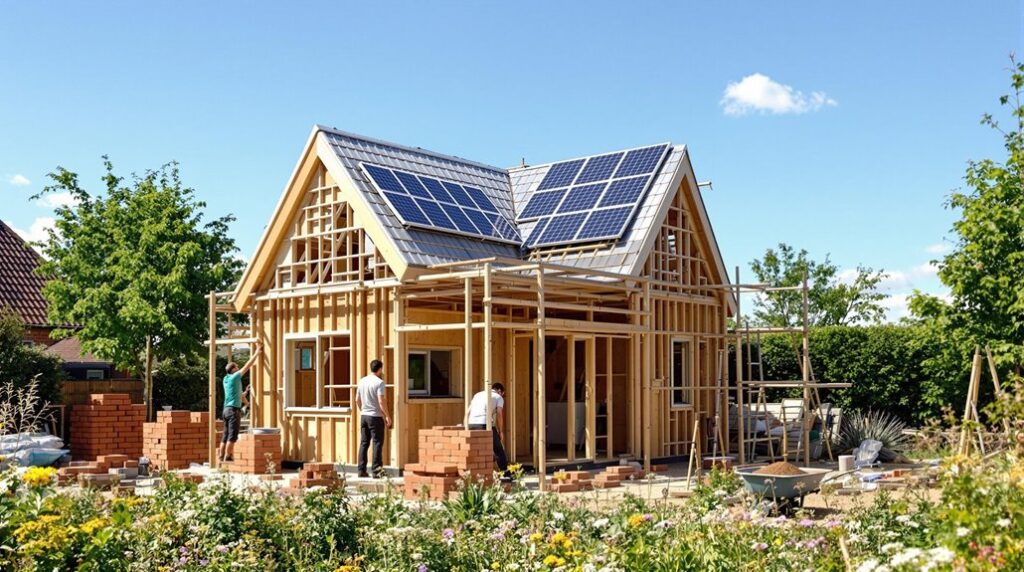I’ve spent years helping homeowners navigate the complexities of building eco-friendly homes without emptying their bank accounts, and I can tell you that sustainable construction in the UK doesn’t have to cost a fortune. The key lies in understanding which green building strategies deliver the biggest impact for your pound, and where you can make smart compromises without sacrificing long-term performance. Let me show you exactly how to prioritize your spending for maximum environmental and financial returns.
Key Takeaways
- Choose timber frame construction starting at £325-£350 per m² or explore plant-based materials like hempcrete for significant cost savings.
- Prioritize fabric-first approach with effective insulation and airtightness to reduce energy bills by 30-60% long-term.
- Source reclaimed timber, recycled bricks, and salvaged fixtures to cut build costs while reducing environmental impact significantly.
- Take advantage of 0% VAT on energy-saving materials and government grants covering 60-90% of eco-build costs until 2027.
- Consider Pretty Good House standard instead of expensive Passivhaus certification for similar energy performance without certification fees.
Understanding Realistic Budget Expectations for Eco-Friendly Builds
While eco-friendly construction carries higher upfront costs, understanding the realistic budget ranges helps you plan effectively without falling into common financial traps. You’re looking at £2,200+ per m² for middle-range eco-builds in 2025, with timber frame construction starting at £325–£350 per m². If you’re pursuing Passivhaus standards, expect £1,500–£3,900 per m² due to advanced insulation requirements. It’s important to consider potential hidden costs that may arise during the renovation process.
A 200m² eco-home typically costs £440,000–£560,000, while compliance with Part L standards adds £5,000–£15,000 for heat pumps and enhanced insulation. Don’t forget certification expenses like EPC costs (£100–£300) and airtightness testing (£500–£1,500). The premium for eco-materials runs £5–£20/m² over standard options, but you’ll achieve 70% energy savings long-term. Projects over £100,000 can greatly benefit from a quantity surveyor, who can identify potential savings of 5–10% and help manage these complex eco-build budgets effectively.
Choosing Cost-Effective Construction Methods and Materials
Once you’ve established your budget framework, selecting the right construction methods and materials becomes your primary lever for controlling costs while maintaining eco-friendly performance. I recommend prioritizing timber-based systems like Cross Laminated Timber (CLT) or Structural Insulated Panels (SIPs), which reduce labor costs through faster assembly while providing excellent thermal performance. Additionally, using renewable materials not only supports sustainability but can also lead to long-term savings on energy bills.
For ultra-low budgets, consider plant-based materials like hempcrete or cob construction using local clay and straw. These materials offer significant cost savings when you’re willing to invest sweat equity. Hempcrete is particularly noteworthy as a better-than-zero carbon material that actually removes more carbon from the atmosphere than is produced during its creation. Recycled materials, particularly shipping containers, provide modular solutions with rapid assembly times.
Natural materials like rammed earth leverage on-site resources, minimizing transportation costs. When conventional materials are necessary, specify low-carbon concrete with fly ash content to reduce both environmental impact and material expenses.
Implementing the Fabric-First Approach to Minimize Expenses
After selecting your construction methods and materials, implementing a fabric-first approach becomes your most powerful strategy for slashing long-term expenses while meeting stringent environmental standards. I’ll prioritize optimizing your building envelope before considering any mechanical systems, which cuts energy bills by 30-60%. This approach is essential for ensuring compliance with upcoming government standards.
You’ll focus on three critical elements: insulation, airtightness, and thermal bridge elimination. I recommend using cost-effective mineral wool or PIR insulation throughout walls, roofs, and floors. Position your building to maximize free solar heat gain and natural lighting—this eliminates expensive active climate control.
Seal every joint and penetration meticulously during construction. This precision prevents costly post-construction fixes and reduces heating demands dramatically. You’ll install smaller, less expensive ventilation systems only after fabric optimization. Quality workmanship is crucial for achieving maximum energy efficiency and preventing expensive remedial work later. This approach aligns with UK Building Regulations, preventing expensive retrofits later.
Selecting Sustainable Materials That Won’t Break the Bank
Your building envelope’s performance depends heavily on the materials you choose, and sustainable options can deliver both environmental benefits and cost savings when selected strategically. I’ve found bamboo offers exceptional strength-to-weight ratios while growing rapidly, making it cost-effective through reduced transportation costs. Recycled steel and plastic divert waste from landfills whilst providing durability at lower prices than new materials.
Natural earth-based materials like cob and rammed earth deliver excellent thermal mass and insulation properties while being locally sourced. Cob requires little processing, making it particularly cost-effective for budget-conscious builders. For insulation specifically, I recommend cork or sheep’s wool – both provide superior thermal performance with moisture-wicking capabilities. Additionally, 3D printed homes can also utilize innovative materials, further enhancing the sustainability and efficiency of construction.
Innovative composites like mass timber and Timbercrete combine sustainability with structural strength. These materials sequester carbon whilst meeting British Standards requirements, ensuring you’re building responsibly without compromising on performance or budget.
Maximizing Energy Efficiency Through Strategic Design Choices
While selecting sustainable materials forms the foundation of eco-friendly construction, strategic design choices determine how efficiently your home uses energy throughout its lifetime. I’ll focus on proven methods that deliver maximum impact without excessive costs.
Prioritising insulation addresses the biggest energy losses first. With 5.1 million UK properties lacking cavity wall insulation and 7.9 million homes having inadequate loft insulation, these upgrades offer immediate returns. Government schemes installed 420,600 energy efficiency measures in 120,900 households during 2024, proving widespread support exists. External insulation provides superior retrofitting benefits by reducing thermal bridges and enhancing thermal mass compared to internal alternatives. Additionally, ensuring air tightness in your home significantly reduces energy consumption by minimizing unwanted air leaks.
Combining airtight construction with mechanical ventilation and heat recovery systems retains up to 90% of heat that would otherwise escape. Triple-glazed windows with U-values below 0.8 W/(m²K) and strategic south-facing orientation maximise natural solar gain while minimising heat transfer.
Utilizing Reclaimed and Recycled Materials for Budget Savings
Smart design choices set the stage for energy efficiency, but material selection determines both your budget and environmental impact. I’ve found reclaimed materials can slash costs by 50-75% compared to new equivalents. You’ll discover quality wood, metal, and structural elements at demolition sites, salvage yards, and online marketplaces.
The UK’s construction industry generates 59.4 million tonnes of waste annually, yet achieves a 94.3% recovery rate – there’s abundant material available. I source reclaimed timber for framing, recycled bricks for walls, and salvaged fixtures for interiors. These choices reduce landfill waste while cutting your build costs considerably. Recycling centers provide exceptional variety and quality, so calling ahead ensures you secure the best materials for your project. Additionally, utilizing approved repair techniques for maintaining reclaimed materials can enhance their longevity and performance in your build.
Check local reclamation centres first, then expand to specialised dealers. Inspect materials thoroughly for structural integrity, and factor delivery costs into your budget calculations.
Exploring Prefabricated and Kit Home Options

Although traditional construction methods dominate the housing market, prefabricated and kit homes offer compelling advantages for budget-conscious eco-builders. I’ve found that modular homes construct twice as fast as conventional builds while reducing labor costs by 30%. You’ll benefit from factory-controlled production that minimizes material waste by 40-60%, directly impacting your budget. Additionally, many modular homes are designed with innovative technologies that enhance energy efficiency, making them a smart investment for the future.
The energy efficiency gains are remarkable – these homes are 55% less heating-dependent than traditional UK houses. With precast concrete components and enhanced insulation exceeding current regulations, you’re investing in long-term savings. The UK government supports this approach through expedited planning permissions and policy frameworks aligned with Future Homes Standard 2025.
Factory production eliminates weather delays, and standardized components enable cost-efficient purchasing. These construction methods deliver homes with 75-80% carbon reduction compared to conventional builds, positioning your investment ahead of upcoming regulatory requirements. You’re joining a growing community as this sector delivers 20,000 energy-efficient homes by 2025.
Government Incentives and VAT Benefits for Eco Builds
Beyond the inherent cost savings of prefabricated construction, you’ll discover that government incentives can dramatically reduce your eco-build expenses even further. The 0% VAT rate on energy-saving materials like insulation and solar panels runs until 2027, cutting upfront costs by 15-25%. You’ll need BSI-certified materials and contractor certification to claim this relief.
While the Warm Homes Grant typically excludes new builds, Energy Efficiency Grants 2025 support various eco-upgrades that can reduce your carbon footprint by 20%. I recommend checking local authority platforms for GHG-derived funding opportunities that might apply to your project. Additionally, staying informed about upcoming landlord fines can help you avoid any potential regulatory pitfalls while enhancing your property’s sustainability.
The ECO4 scheme offers additional support if you’re income-eligible. Enhanced energy performance from these improvements can increase property values, attracting prospective buyers and providing long-term financial returns on your investment. When you combine multiple incentives strategically, they can cover 60-90% of your eco-build costs, making sustainable construction genuinely affordable.
The Pretty Good House Alternative to Expensive Passivhaus Standards
While Passivhaus certification delivers exceptional energy performance, its rigid requirements and premium costs can push eco-builds beyond reach for budget-conscious homeowners. That’s where I’d recommend considering the Pretty Good House standard – a flexible alternative developed by practical builders who understand real-world constraints.
I appreciate how PGH eliminates expensive certification fees while targeting similar energy performance (≤30 kWh/m²/year). You’ll achieve 75-90% energy reduction compared to conventional homes through proven strategies: superinsulation with dense-packed cellulose, airtightness testing at ≤1.5 ACH50, and strategic window placement mixing triple-glazing with quality double-glazing. This approach aligns with the principles of energy-efficient construction that are becoming increasingly vital in the UK housing market.
The beauty lies in phased implementation – you can upgrade systems over time rather than front-loading massive costs. This approach prioritizes envelope-first design using locally sourced materials, making high-performance eco-building genuinely accessible. The standard emphasizes the KISS principle for ease of operation and maintenance, ensuring your eco-friendly home remains practical for long-term living.
Long-Term Financial Benefits of Energy-Efficient Home Design
The Pretty Good House approach I’ve outlined delivers impressive upfront savings, but the real financial magic happens over decades of ownership. I’ve seen energy-efficient homes cut utility bills by 75-80%, with some owners saving £48,000+ over 30 years. Your property’s resale value will jump 5-10% with high EPC ratings, while 72% of Gen Z buyers now prioritize efficiency ratings. Additionally, making your home more energy-efficient can significantly reduce your carbon footprint, contributing to a more sustainable future.
Government schemes continue delivering – the Home Upgrade Grant allocated £630M for retrofits, and green mortgage searches surged 58% in 2024. You’ll dodge energy price volatility through reduced consumption and renewable integration. Maintenance costs drop 30% with passive ventilation systems, while sustainable materials outlast conventional options. Under the 2025 Future Homes Standard, new builds must produce 75-80% fewer carbon emissions than previous regulations require. These aren’t just savings – they’re your shield against inflation and pathway to long-term wealth building.
Conclusion
Building an eco-friendly house on a budget isn’t just possible—it’s financially smart. I’ve shown you how timber frames, hempcrete, and prefab designs cut costs while the fabric-first approach maximizes efficiency. Don’t forget the 0% VAT on energy-saving materials and other government incentives. Your upfront investment in sustainable materials and strategic design choices will pay dividends through reduced utility bills for decades. Start planning your build with these cost-effective strategies today.
References
- https://www.self-build.co.uk/what-does-it-cost-to-build-a-house/
- https://www.theenvironmentalblog.org/2023/01/how-to-build-an-eco-friendly-home/
- https://www.savills.co.uk/research_articles/229130/348619-0
- https://resi.co.uk/advice/design-and-inspiration/eco-friendly-home-guide
- https://www.markosdesignworkshop.com/knowledge/sustainable-construction-pragmatic-approach
- https://globequestconsulting.com/how-to-estimate-building-cost-in-the-uk-guide/
- https://www.ecohome.net/en/guides/3499/top-tips-for-planning-and-building-a-green-home-on-a-budget/
- https://gemmalouise.co.uk/2025/04/eco-friendly-on-a-budget-build-a-sustainable-home.html
- https://buonconstruction.com/will-uk-construction-costs-fall-in-2025/
- https://acarchitects.biz/self-build-blog/sustainable-construction-methods-eco-cat

